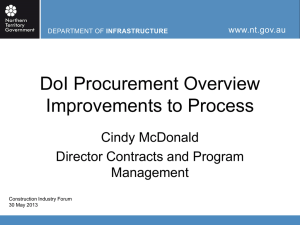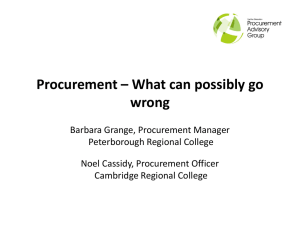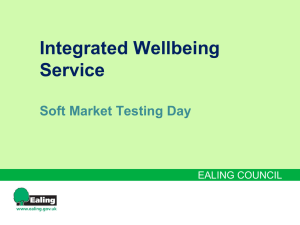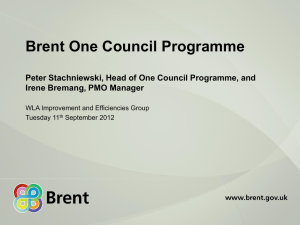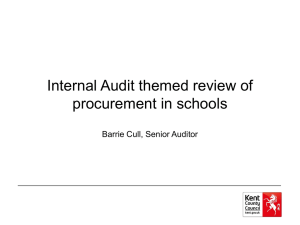The Procurement Process
advertisement
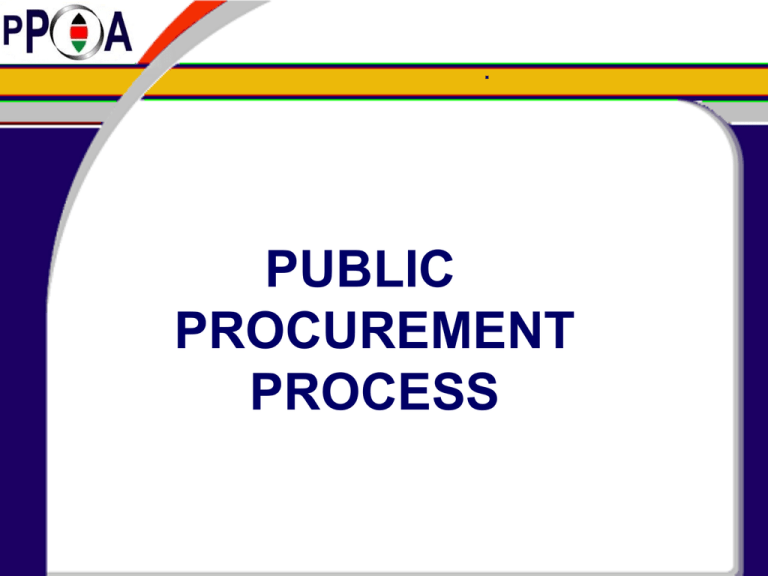
. PUBLIC PROCUREMENT PROCESS Objectives of Good Procurement Acquisition in the most cost effective manner - Right price (lowest evaluated price), In the right quantities, at the right quality, from the right source, at the right time, Delivered at the right place The benefits of good procurement include: Security of supply, Lower total cost, Reduced risk, Improved quality, More added value, Greater efficiency, New innovations.. Objectives of the PPDA, 2005 economy; efficiency; competition; fairness; integrity; transparency; accountability; public confidence in public procurement and disposal; and promotion of local industry and economic development. Importance of Public Procurement Majority of Kenya Vision 2030 flagship projects to be delivered through public procurement. Need for elimination of waste through strategic leadership in public procurement & THE PUBLIC PROCUREMENT PROCESS 1. Identify the Need Responsibility for identification of requirements at Departmental level, Organizational level Consider type of goods, works and services; and when and where needed 2. Undertake Procurement Planning Departments supply their procurement plans which are consolidated Procurement commenced on satisfaction that sufficient funds exist THE PUBLIC PROCUREMENT PROCESS 3.Specification of Requirement It consists of definitive descriptions on the object to be procured. Specifications must be clear, accurate and Complete other wise will result to wrong procurement of goods/services/works Provision of information that the supplier requires in order to reliably meet the user’s expectation. Need for market survey to assist with preparation of specifications e.g bills of quantities Specification to be drawn by the user of the product or service and the SCM function Consultants may be used in preparation of specifications and bidding document THE PUBLIC PROCUREMENT PROCESS Methods of specifications Sample – part of the item to be procured is submitted to the buyer to be used to compare the delivered amount against it to confirm quality adherence and conformance. It is used in textile industry and so on Grading – this method is commonly used in cereals and cash crops to indicate the various quality levels e.g. grade I, II among others Technical illustration – this method is used to describe quality of technical and complex artistic goods such as construction and building works which should be accompanied by technical drawings to confirm quality requirement brand name – this is used to describe quality of goods that are difficult to specify by other means. However, the words; “or equivalent” should be added when specifying using brand names. (section 34(4)) THE PUBLIC PROCUREMENT PROCESS 4. Preparation of Tender Documents Containing Specifications - Bills of quantities, drawings, evaluation criteria, Price schedule, tender forms, sample contract, Preferences and Reservations e.t.c. 5. Choice of Procurement Method a. Open tendering (Open National Tender or International Open Tender)-preferred method b. Others : Restricted Tender, Direct procurement, Request for quotations, Request for proposals, Low value procurement, Specially permitted procedures THE PUBLIC PROCUREMENT PROCESS 6. Publicizing the procurement opportunity Advertising in newspapers, notice boards, websites 7. Availing bidding documents to bidders 8. Submission of bid Documents - provision of tender box - no late tenders 9. Opening of Bids - Appointment of tender opening committee, bidders may participate, and minutes prepared THE PUBLIC PROCUREMENT PROCESS 10. Bid Evaluation: This step involves: a.Preliminary evaluation- and rejection of tenders that do not satisfy the basic requirements (Reg.47) b.Technical Evaluation- comparing each tender to the technical requirements c.Financial Evaluation- comparing tenders to determine the evaluated price of each Tender to consider Preferences and Reservations d.Post qualification- where indicated in the tender documents a Procuring Entity may, prior to award of the tender confirm the qualifications of the lowest evaluated tenderer THE PUBLIC PROCUREMENT PROCESS 10. Award of Tender by Tender Committee Tender committee Quorum to be FIVE including the Chairman Decision through consensus Minutes of Tender Committee to be prepared 12. Notification of Award and Appeal Window Period i. Notification to winner and losers simultaneously ii. Bidders has a right to seek administrative review on PE’s decisions iii. Bidders right to seek judicial Review THE PUBLIC PROCUREMENT PROCESS 13.Contract Management Execution of contract Inspection and quality assurance-by Inspection & Acceptance committee Handling, claims and disputes Administering payment provision. Overdue payments to be paid with interest Variations to Contracts allowed on price and quantity as per Regulations Contract Termination - To be approved by the tender committee. THE PUBLIC PROCUREMENT PROCESS 14. Disposal of surplus, obsolete or/and unserviceable stores by use of the following methods Transfer to another entity sale by public tender sale by public auction destruction, dumping or burying trade-in Restriction on disposal to employees to be set out in the regulations. CONCLUSION PPDA,2005 outlaws inappropriate influence in the procurement process PPOA is mandated with carrying out procurement assessments, audits and reviews and issue directions PPDA,2005 makes it mandatory for Procuring Entities to report to PPOA on prescribed activities The Director General of PPOA with the approval of PPOAB may debar a person from participating in procurement proceedings Compliance with PPDA,2005 and PPDR,2006 results in economy, efficiency, fairness, competition, transparency, public confidence and promotion of local industry.



